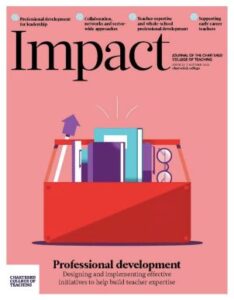A reflection on how a work–life balance can be achieved using professional development

Suzanne Allies, Senior Lecturer, School of Education, University Of Worcester, UK
The ability to maintain a work–life balance for many teachers can feel unattainable; indeed, research seems to confirm and reinforce this (Education Support, 2020). I only gained some semblance of balance between my personal responsibilities and the demands of teaching in the last five years of my 20-year teaching career. Later, as a university lecturer, the trainee teachers and early career teachers with whom I interacted regularly admitted that their personal lives began disappearing under a mountain of paperwork, sadly leading to a disillusionment with teaching. Many shared how hobbies and interests that once nurtured them had fallen by the wayside; this is not how it should be. I was prompted to write a book about teacher wellbeing in a small attempt to help.
This article outlines recent research on teacher work–life balance. It also presents the argument that all teachers, especially those new to teaching, should undertake professional development to learn tools and techniques to create more work–life balance. Providing teachers with opportunities such as this demonstrates a proactive approach from school leaders, as opposed to a reactive approach, when teachers are only offered support after they experience stress and overwhelm due to overwork.
What does a work–life balance look like?
Eyre (2017, p. 74) presents an image of the ideal work–life balance as a large circle representing ‘life,’ with a smaller circle within it to represent ‘work’. This is to show that work should give us meaning and purpose and be integrated into the rest of our lives, but should be given less significance than the ‘life’ part.
Do teachers have a work–life balance?
The National Foundation for Educational Research (2019) found that teachers experience higher levels of job-related stress and a poorer work–life balance because their work is so intensive during term times. What is more, we know that work does not stop for teachers come the holidays. Pillen et al. (2013, p. 254) studied the key tensions of new teachers, such as ‘wanting to invest time in a private life while feeling pressurized to commit time and energy to work’. A coping strategy that they recommended for new teachers is to seek support and understanding from a trusted mentor or colleague, the aim being to elicit guidance and provoke purposeful discussions about work–life balance, alongside searching for a solution themselves.
The failure to maintain a work–life balance continues to have a detrimental impact on teachers. In the Teacher Wellbeing Index 2020, 65 per cent of educational professionals cited a lack of work–life balance as their top issue. Within this finding, 81 per cent were senior leaders and 61 per cent were teachers (Education Support, 2020, p. 40). This suggests that a healthy work–life balance is not being modelled to staff by many school leaders. Alarmingly, some participants admitted to working more than 61 hours per week, which would surely leave very little time or energy for non-work pursuits. Rath and Harter (2010) found that one’s sense of pride increases with the hours worked, which explains the need in some staff to continue working past their contracted hours or directed time. If teachers are working extensive hours, it is no wonder that Kell (2018) discovered that the neglect of ‘other responsibilities’ outside of teaching was among the top four reasons that teachers attributed in their decision to leave the teaching profession. Teacher participants in the Cooper Gibson research (DfEDepartment for Education - a ministerial department responsible for children’s services and education in England, 2018, p. 34) highlighted that the extensive hours they work, along with the high levels of ‘expertise, experience and dedication’ they demonstrate, is not being reflected in their salary. In addition, those with families pleaded for increased flexibility to enable them to balance home life and work (DfE, 2018).
How has the pandemic affected work–life balance?
Extra challenges have been placed onto teachers due to the pandemic. Boundaries between home and work became more blurred due to the introduction of virtual lessons (Bintliff, 2020). A Chartered College of Teaching survey (Müller and Goldenberg, 2020) found that many teachers were ‘finding it more difficult to juggle work and home life than pre-lockdown’ and that some were ‘balancing distance learning, key worker provision, additional administrative tasks, home-schooling their own children or caring for vulnerable family members, creating an “unsustainable” increase in workload’ (Civinini, 2020).
This article is focused on recent literature, although it is important to acknowledge that, historically, extensive research on the work–life balance of teachers has been undertaken, although terminology surrounding the topic has tended to vary over time (Kalliath and Brough, 2008). Individual researchers, such as Lizana et al. (2021), continue to investigate the impact of the pandemic on the quality of life of teachers. However, Table 1 summarises the findings of surveys undertaken by various organisations to understand the impact of the pandemic on their work–life balance.
Table 1: A summary of findings from surveys on the impact of the pandemic on work–life balance
| Organisation | Findings |
| National Association of Headteachers (NAHT) survey, July 2020 (Roberts, 2020) | 79 per cent of NAHT members said that, due to work, they had no time to exercise.
Three-quarters said that their job had a negative impact on their family or personal life. |
| Teacher Wellbeing Index, November 2020 (Education Support, 2020) | Teachers who said that they worked, on average, more than 51 hours a week rose to 37 per cent this year (compared with 33 per cent in 2019).
|
| Wellbeing in Education Survey, December 2020 (MeeTwo, 2020) | 93 per cent of teachers said that their jobs had become more pressured since the beginning of the pandemic, with the extra work, responsibility and stress, both at school and at home.
|
| Times Educational Supplement (TES) survey, February 2021 (Lough, 2021) | 62 per cent of teachers said that they felt drained and mentally exhausted during autumn 2020.
17 per cent said that they felt ‘physically and mentally on the brink’. |
| National Foundation for Educational Research (NFER) report, March 2021 | Teachers’ weekly working hours rose to 46 following the phased reopening of schools in June 2020 (the average full-time UK employee works 42.5 hours).
|
| National Education Union survey, April 2021 (Weale, 2021) | One in three UK teachers plans to quit the classroom within five years because of increased workload.
Teachers said that they were exhausted after a year of COVID disruption, and 70 per cent reported increased workload. 95 per cent were worried about the impact on their wellbeing. |
These concerning statistics suggest the need to further prioritise teacher wellbeing so that staff, students, community and recruitment of teachers all benefit (Pountain, 2020). On a positive note, however, the DfE congratulated school staff on the ‘resilience and commitment’ displayed during the pandemic. They have promised to take ‘considerable action to address teacher workload and wellbeing’ by investing millions in supporting teachers (Thorn, 2021). This, therefore, paves the way for schools to gain funding for professional development sessions to urgently encourage a work–life balance in their staff.
What are some practical ways in which to support a work–life balance?
I believe that it is space, and not time, that teachers need more of: they require more mental and physical space and the chance to breathe and experience freedom from constant teaching pressures (Allies, 2020). I noticed that when I began to carve out a proportion of my day that was dedicated to gaining more space, a shift occurred. I became more productive at work and felt as if I was working to live, rather than living to work. I have used the acronym SPACE to highlight five focus areas for teachers to consider within professional development sessions designed to promote a work–life balance:
- SCHEDULE: I recommend that a teacher should schedule ‘me time’ into the working week and aim to devote at least one hour each day to a ‘rest activity’, such as having a bath or listening to music. It is useful to pick a regular time to suit – mine was 7.00 to 8.00pm. It is important to plan this time into each day in advance; otherwise it will get consumed by something else. Furthermore, booking a holiday or weekend retreat may provide a boost on tiring and hectic days. It is advisable not to work until there is no energy left to devote to pastimes, or a teacher’s life will merely consist of work and sleep. Being disciplined is crucial; it may even be helpful to set a timer to leave school and to gain an acceptance that it is unrealistic for any teacher to finish all daily tasks. Living according to one’s values will aid job satisfaction for a teacher. For example, if relationships are important to a teacher’s happiness, then they should ensure that they spend quality time with family and friends. Lastly, I suggest that a teacher dedicates one day of the weekend to complete rest from work and reminds themselves that they will not teach effectively if they are tired.
- PRIORITISE: The second focus is to prioritise work tasks to allow more time for personal pursuits. The Eisenhower method (Mulder, 2017) categorises tasks into levels of urgency/importance so that a teacher can decide when to attend to a task, delegate or drop a task. I suggest that teachers practise breaking down tasks into manageable chunks and rewarding themselves when jobs are complete. Having regular breaks is the secret to increased productivity (Allies, 2020).
- AUDIT: Thirdly, a useful exercise for teachers is to create an audit to establish the time that they devote to certain tasks, like planning and marking. Sharing these audits in staff meetings may illuminate where change is needed. For example, if it is exposed that a lot of time is spent by staff on administrative tasks, then an audit on administrative tasks can next identify which tasks can be simplified, aborted or undertaken by administrative staff instead. The only drawback is the time being taken to complete the audits. However, this will be offset by the long-term benefit of initiating change at a whole-school, personalised level.
- CULTURE: Next, I’d like to emphasise the importance of building a positive school culture around wellbeing and a work–life balance. I would argue that this is the most important aspect and should be discussed in detail during professional development sessions. Sadly, some schools sustain and reinforce the idea that teachers should be resigned to not expecting a work–life balance and this, damagingly, then becomes the norm. Any change in school culture usually starts with senior staff modelling and being explicit about how many hours they expect staff to realistically work. School leaders need to praise those staff striving for a work–life balance and leaders need to talk openly about prioritising their own self-care. If a school expects a teacher to be a workaholic, then it is time for them to escape or fight the misplaced logic of that expectation. To add more socialisation at school, it may be supportive for school staff to set up a variety of staff clubs – for instance, fitness or relaxation-focused activities, or times for regular staff breakfasts.
- ESTABLISH: Lastly, in professional development sessions, teachers need to discuss how to establish healthy work–life balance habits, such as learning to say ‘no’ and letting go of perfectionist tendencies by accepting ‘good enough’ when needed. In addition, it is advisable as a teacher to ignore work emails in the evenings and weekends. Again, it is beneficial if school leaders encourage this; I will always remember my relief when my line manager heard the ping of an email notification on my phone and immediately instructed me to turn it off. This kindness gave me permission to stop such a damaging habit. In addition, teachers may benefit from spending a little time acclimatising to being at home after school by performing a ritual, like having a shower, to aid this transition so that it is easier to leave any work anxiety behind.
What changes can be implemented in light of the pandemic?
The pandemic may have highlighted how vital it is to support wellbeing first and foremost. I would like to think that many teachers may have incorporated new routines into their lives that have enriched it; it is important not to lose sight of these when fully returning to old patterns and schedules. In the same way, if schools have recently embraced technology – for example, by meeting remotely instead of face to face – continuing to utilise this will give school staff more flexibility and limit time spent travelling. Reflections from teachers in Kim et al.’s study (2021, p. 23) highlighted how, following the pandemic, teachers had a new appreciation for what was important in their personal and professional lives, including an ‘enhanced understanding that work–life boundaries should be in place’.
To conclude, it is worth remembering that creating a healthy equilibrium in our lives is essential as, if a teacher works too extensively, they will only be able to sustain this ongoing pressure for so long before they risk their health. Engaging in out-of-work activities tends to improve productivity and job satisfaction, which is worth recalling if as a teacher you opt to continue marking books instead of doing something more pleasurable.
References
Allies S (2020) Supporting Teacher Wellbeing: A Practical Guide for Primary Teachers and School Leaders. Abingdon: Routledge.
Bintliff AV (2020) How COVID-19 has influenced teachers’ well-being. Available at: www.psychologytoday.com/gb/blog/multidimensional-aspects-adolescent-well-being/202009/how-covid-19-has-influenced-teachers-well (accessed 13 June 2021).
Civinini C (2020) Teacher workload ‘unsustainable’ during lockdown. TES, 21 July, 21. Available at: www.tes.com/news/teacher-workload-unsustainable-during-lockdown (accessed 11 April 2021).
Department for EducationThe ministerial department responsible for children’s services and education in England (DfE) (2018) Factors affecting teacher retention: Qualitative investigation. Research report, CooperGibson Research. Available at: https://assets.publishing.service.gov.uk/government/uploads/system/uploads/attachment_data/file/686947/Factors_affecting_teacher_retention_-_qualitative_investigation.pdf (accessed 31 March 2021).
Education Support (2020) Teacher Wellbeing Index 2020. Available at: www.educationsupport.org.uk/resources/research-reports/teacher-wellbeing-index-2020 (accessed 13 June 2021).
Eyre C (2016) The Elephant in the Staffroom: How to Reduce Stress and Improve Teacher Wellbeing. Abingdon: Routledge.
Kalliath T and Brough P (2008) Work–life balance: A review of the meaning of the balance construct. Journal of Management Organisation 14: 323–327.
Kell E (2018) How to Survive in Teaching: Without Imploding, Exploding or Walking Away. London: Bloomsbury.
Kim LE, Leary R and Asbury K (2021) ‘We need clear directions, if we’re going to move forward. It’s as simple as that’: Teachers’ narratives during partial school reopenings in the COVID-19 pandemic. Education Research. DOI: 10.1080/00131881.2021.1918014.
Lizana PA, Vega-Fernadez G, Gomez-Bruton A et al. (2021) Impact of the COVID-19 pandemic on teacher quality of life: A longitudinal study from before and during the health crisis. International Journal of Environmental Research and Public Health 18(7): 3764.
Lough C (2021) Exclusive: Exhausted teachers ‘pushed to the brink’. TES, 13 February, 21. Available at: www.tes.com/news/exclusive-exhausted-teachers-pushed-brink (accessed 11 April 2021).
MeeTwo (2020) MeToo Wellbeing in Education survey results 2020. Available at: https://static1.squarespace.com/static/5e7277b1d1518438b2ae44e5/t/5fd3545e6d2eb560c6b633f9/1607685238919/MeeTwo%27s+Wellbeing+in+Education+Survey+Results+Dec20.pdf (accessed 11 April 2021).
Mulder P (2017) Eisenhower Matrix. Available at: www.toolshero.com/%20personal-development/eisenhower-matrix (accessed 24 April 2021).
Müller L-M and Goldenberg G (2020) Education in times of crisis: Teachers’ views on distance learning and school reopening plans during COVID-19. Chartered College of Teaching. Available at: https://my.chartered.college/wp-content/uploads/2020/07/EducationInTimesOfCrisisII_20200708_final.pdf (accessed 13 June 2021).
National Foundation for Educational Research (NFER) (2019) More teachers feel ‘tense’ or ‘worried’ about their job than those in comparable professions. Available at: www.nfer.ac.uk/news-events/press-releases/more-teachers-feel-tense-or-worried-about-their-job-than-those-in-comparable-professions (accessed 21 April 2021).
Pillen M, Beijaard D and den Brok P (2013) Tensions in beginning teachers’ professional identity development, accompanying feelings and coping strategies. European Journal of Teacher Education 36(3): 240–260.
Pountain C (2020) Why wellbeing should be at the heart of school culture. TES, 26 June, 20.
Available at: www.tes.com/news/why-teacher-wellbeing-should-be-heart-school-culture (accessed 28 March 2021).
Rath T and Harter J (2010) Wellbeing: The Five Essential Elements. Gallup Press.
Roberts J (2020) Exclusive: Headteachers losing sleep due to work stress. TES, 16 July, 20. Available at: www.tes.com/news/exclusive-headteachers-losing-sleep-due-work-stress (accessed 8 April 2021).
Thorn R (2021) Covid: Teachers pushed to ‘breaking point’ under lockdown. BBC News. Available at: www.bbc.co.uk/news/uk-england-devon-55737787 (accessed 23 April 2021).
Weale S (2021) One in three teachers plan to quit, says National Education Union survey. The Guardian, 8 April, 21. Available at: www.theguardian.com/uk-news/2021/apr/08/one-in-three-uk-teachers-plan-to-quit-says-national-education-union-survey (accessed 11 April 2021).










